SIGN GUESTBOOK |
READ GUESTBOOK |
|
FEMALE GALLERIES |
INDEX |
SIGN GUESTBOOK |
READ GUESTBOOK |
|
FEMALE GALLERIES |
INDEX |
![]()
In the middle age, the ideals of beauty and aesthetics were lost. These centuries were dark and full of sickness and dearth. So, we could say that only in the beginning of 19th century, bodybuilding returned.

A group of russian strongmen. The strongmen were the pioneers of modern bodybuilding. They were poliedric personalities, being weightlifters, wrestlers, circensians and sometime actors. The last man on the right (up) is Viktor Solevev, a world famous wrestler in the beginning of 20th century.
Hippolyte Triat
The French Hippolyte Triat (1813 - 1881) affirmed that using dumbbells a man could sculpt his body. The idea of "french training" was born in this period: Triat discommended the use of heavy weights to prevent accidents, so also today we associate the word "french training" with the idea of light weights and a very high number of repetitions .

Hyppolite Triat. He used the first dumbbell of 84 kg (185 lbs.), built in 1838. Truly speaking, the dumbbell would have been 90 kg, but the second sphere was littler than the first, so that this tool was asimmetric and difficult to use. This dumbbell is conserved in the "Musée de l'Homme" in Paris. Only Triat and Cadine, another french weightlifter, were able to lift this tool with one arm.
Eugen Sandow (Friedrich Wilhelm M�ller)
"In the Victorian era, men were always dressed,
and the artists who draw nudes were not much.
Also for this reason the charm of Sandow was so exciting."
Arnold Schwarzenegger, "Encyclopedia of modern bodybuilding"
The opposite ideas of Triat were followed by german and austrian weightlifters.
Friedrich Wilhelm Müller (1867 - 1925)
used heavy weights and short trainings (15 minutes each) to stimulate
muscles. Müller was the father of modern bodybuilding and also
a very cunning businessman.
He was born in Königsberg, in Prussia (now Kaliningrad in Russia)
and, still adolescent, he visited the whole Europa, working as circensian.
In 1887, he knew in Bruxelles the German
Louis Attila (which the real name was
Louis Durlacher), a very famous strongman. Attila was
a pupil of Triat, and created an high number of exercises.
In 20th century, Attila went to New York and
there opened a gym.
Attila, working with some german colleagues,
founded the basis of structured training: they understood that using
weights and increasing them in a structured and sistematic way, the
body's muscles could grow.
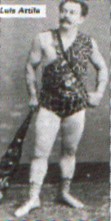
Louis Durlacher (Louis Attila, also know as Professor Attila). Karlsruhe (Germany) 1844 - New York City (NY, USA) 1926. One of the strongest men of the end of 19th century. He invented the Roman chair (to train abdominals), the modern barbell and the bent press exercise.
While Triat made the first modern dumbbell of 84 kg, Attila and
Karl Abs (1815 - 1895),
another german strongman, created the first modern barbell. Using
this tool, Attila invented very effective exercises, since they were
simmetric and stimulated equally left and right muscles.
Another advantage of the barbell is that it's possible to increment weight
using the same bar, while the dumbbell's weight is fixed.
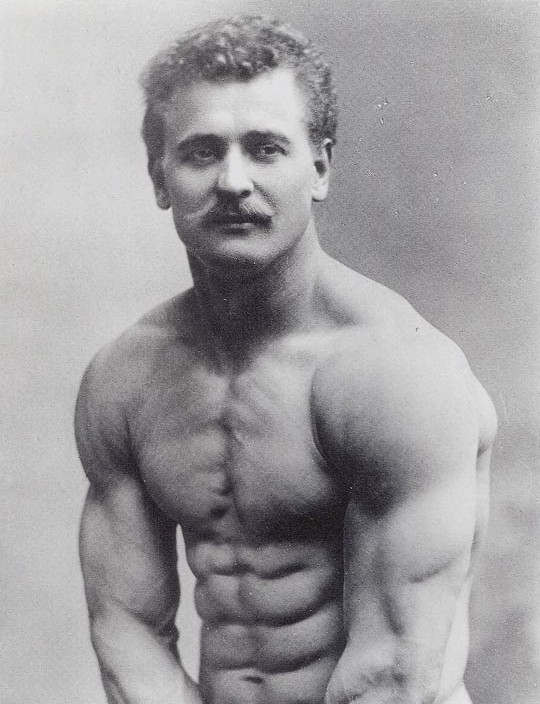
Friedrich Wilhelm Müller (Eugen Sandow). Notice how this man, with the limited knowledges in fact of training and diet, built a muscular body of 83 kg (183 lbs.) !
Müller was a strong man, stronger than Attila, but also stronger than
Charles Sampson, an english man, who substained to be the
"strongest man in the world".
After years of training with Attila, Müller was ready to go to
London to challenge Sampson and his pole pupil Franz Bienkowski
(also known as the Cyclops)
and he demonstrated to be stronger than them.
After this exploit, Müller changed his name into
Eugen Sandow. In London, he built the first modern gymnasium
at 32, St. James Street, but as
I've said, he was very cunning. While the other gyms were dirty and
only for brutal men, Sandow's gymnasium were clean and reserved to a
particular class of clients - the richest ones.
Sandow used very high weights to increase his force and to build
muscles, but he trained his clients very softly. Only a little part of
Sandow's clients practiced really body-building.
However, in a separate room !
At page 5 of Body-building, or man in the making, a book of Sandow, we read: " It was in the beginning of 1897 that I opened my first school of Physical Culture [...], but since then the demand has been so great from those who prefer to do their work under the watchful eye of an efficient, qualified instructor, that I have been compelled to considerably enlarge my Institute, and in addition I have organised a system of postal instruction, of which residents in all parts of this country and abroad are extensively availing themselves. " So with Sandow was born a particualar kind of business: the courses by correspondeance. As you will read in next chapter, also an italian man, expatriate in USA, became rich and famous with the "Dynamic Tension TM" course, another "system of postal instruction".
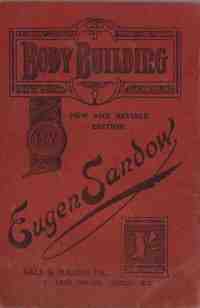
Sandow's essay on bodybuilding. In the first page of this book, there are some kinds of diets. Sandow advises to eat cereals, meat and vegetables. To increase the apport of protein in the diet, Sandow recommend to use "Plasmon" (egg white's powder). Thus, we are in front of the first integrator of the history !
While the ideas of Sandow - the man - are desputable, his ideas about bodybuilding are intersting and very modern. He wrote also some books about this sport; the most important are: Strenght, and how to obtain it and Body-building, or man in the making, which describes many exercises. He was a friend of Sir Arthur Conan Doyle, the author of Sherlock Holmes books. Conan Doyle wrote the preface of the Sandow's book The construction and reconstruction of human body.
Sandow had a wife, Blanche Brookes, and two daughters, Helen and Lorraine, but in New York he lived with his male friend Martinus Sieveking (1867-1950), a music composer born in Amsterdam and one of the first bodybuilders.
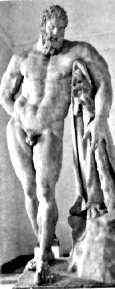
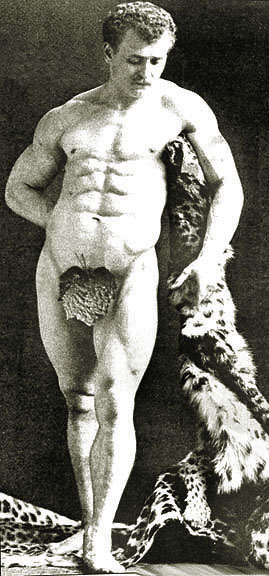
Left: The colossal statue of "Ercole Farnese", conserved in the National Museum of Napoli, Italy. Right: Eugen Sandow in the same pose (1898). He wrote, in his book Body-Builing, or man in the making: "amongst the many fine statues is that of the Farnese Hercules, from the contemplation of which during a visit to the museum that I first conceived the idea of developing my body to the same pitch of perfection as was represented in the antique sculpture."
Sandow, Doyle and Sir Charles Lawes (a sculptor of London) made in 1901 the world's first competition of bodybuilding in Royal Albert Hall of London. The winner was a man of Birmingham, W. L. Murray, who received a little statue representing Sandow himself. It's intersting to notice that, 64 years later, a similar statue was given to Larry Scott, the winner of 1965 Mr. Olympia and every year this statue is given to the winner of this competition.

A statue of Sandow with a barbell.
Bodybuilding in the rest of Europe
In 1890 in Milan (Milano, Italy) was born the first club of
weightlifting: the so called "Club Atletico Milanese",
created by Luigi Monticelli Obizzi.
A famous italian strongman, migrated in USA, was
Clevio Massimo, who wrote
the book Modern Hercules.
In Austria, Franz Stoher and
Karl Böhling
were the pioneer of bodybuilding. As we have said, Sandow
promoted this sport in England, while in France this was done by Triat
and in Germany by Abs.
In Russia, Dr. Krapewsky, doctor of
the Zar, promoted the training with weights. One of his pupil was
George Hackenschmidt
- Lion of Russia - the inventor of the "Hack Squat" machine
and a very famous wrestler.
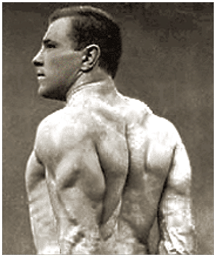
George Hackensmidt. His invention, the "hack squat" machine, is used also today, as a mean to train legs in a more safer way.
![]()
Links
About Sandow and "ancient" body-builders: www.sandowmusem.com and www.sandow.plus.com which contains the books of Sandow, and many many others.
![]()
